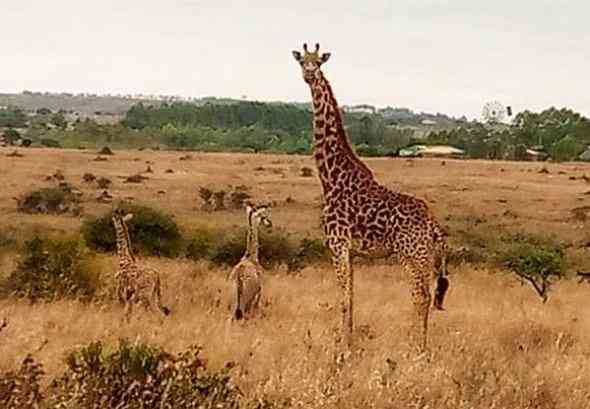
Tourism and Wildlife cabinet secretary Najib Balala has instructed Kenya Wildlife Service authorities to track and ensure the safety of giraffe twins that were born in Nairobi National Park recently.
In an interview with The Standard on Tuesday, Balala said said the birth of the twins will further uplift the profile of the park as a unique wildlife conservation area within the city.
"Although there are predators in the park, I have given instructions to Kenya Wildlife Service to track and secure both the mother and the babies," he said.
In an earlier tweet, Balala said the birth of the twin giraffes is a rare event that ought to be secured for posterity. "One of the Maasai giraffes in Nairobi National Park has given birth to a set of twins. This is an extremely rare occurrence. We welcome the newborns with love," he said.
According to KWS, so rare is giraffe twinning with the rate of such births being one in every 280,000.
In true Kenyan fashion, the news generated hilarious online responses as some suggested what they felt were appropriate names.
J. Sanzi suggested they should be named Nai and Robi (for Nairobi) while El Danza said they ought to be called Hakuna and Matata for the popular Swahili phrase popularised by the animation Lion King.
Then there are those who felt KWS should give a treat to the mother for the "tall" order of carrying twins for 15 months, one of the longest gestation periods in the animal kingdom.
A mother giraffe, standing at almost 5.7 metres tall, gives birth while standing with the baby dropping close to two metres to the ground. Within an hour though, the baby giraffe is usually up and running to evade predators.
"A new born baby giraffe can be about 6 feet tall. I cannot imagine the discomfort that mummy giraffe went through. Give her a treat please," another tweet reads.
Still, there are those who felt the twins may not survive for long due to the abundance of predators within the park. Lions have been known to prey on giraffes and the new mother will have a challenge protecting the babies from the apex predators.
Scientists opine that only a quarter of giraffe babies survive into adulthood due to high cases of predation.
in another tweet, @JhokiAnita inferred that such protection could have been offered by the father of the twins, who was missing as per the picture shared on social media. "Congratulations to the mother and children. Baba ako wapi? Job?" the tweet read.
Kenya has a population of 34,240 giraffes comprising the Masai giraffe, Reticulated giraffe and the Nubian giraffe. They are widely distributed in different ecosystems with the Masai giraffe found mainly in the southern part of the country including Nairobi.
However, Amboseli conservation area has the largest concentration of giraffes with more than 6,000 roaming in the area.
Reticulated giraffes, on the other hand, are found mainly in the north and northeastern parts of the country including Wajir, Garissa, Mandera, Turkana, Laikipia, and Samburu. The Nubia giraffe is found in Ruma National Park located in Homa Bay county, Lake Nakuru National Park, and in private ranches in Naivasha.
A report by Africa Wildlife Foundation shows that giraffes have lost 40 percent of their population in 30 years, with poaching and wildlife trafficking contributing to the decline. However, the biggest threat to their survival is habitat loss as a result of competing land use interests.
"As human populations grow and increase agricultural activities, expand settlements, and construct roads, the giraffe is losing its beloved acacia trees, which are its main source of food," says the report.
 The Standard Group Plc is a multi-media organization with investments in media
platforms spanning newspaper print
operations, television, radio broadcasting, digital and online services. The
Standard Group is recognized as a
leading multi-media house in Kenya with a key influence in matters of national and
international interest.
The Standard Group Plc is a multi-media organization with investments in media
platforms spanning newspaper print
operations, television, radio broadcasting, digital and online services. The
Standard Group is recognized as a
leading multi-media house in Kenya with a key influence in matters of national and
international interest.



